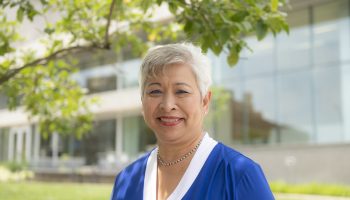
In 2013, lifelong Chautauquan William “Bill” Braham presented a group of graduate architecture students earning degrees in environmental building design at the University of Pennsylvania with a challenging team project: What would it take to support the population of Chautauqua County with renewable resources?
“The question I had them pose was the most extreme version,” Braham said. “What if you had to make and do everything” within this geographic area using only renewable energy and resources? “That’s the long-term question. The short-term is, how do you transition buildings and vehicles within 20 years? … I had just built a house in Chautauqua, so I was interested in the hypothetical of building a house in Jamestown. … This was my using Chautauqua to help them learn.”
In part, Braham’s project led to a playable online game described in a paper co-authored with this team and published in the July 2016 edition of The Journal of Environmental Accounting and Management: “The New Chautauqua Game: Designing the Renewable City and Region Using E[m]ergy Accounting.”
At 9:15 a.m. Tuesday on the porch and front lawn of the Chautauqua Women’s Club House, Braham will kick off the CWC’s 2021 local speakers series with a presentation titled, “City and Country: Imagining the Renewable Economy of the Near Future.” (The rain date is Wednesday at the same time and place). His intention is to get people talking.
Braham said that this seminar-oriented discussion will focus on what it will take to transition to a renewable economy and what that economy will look like. As examples of urban and rural places, he will focus on Philadelphia and Chautauqua.
Greater Philadelphia has been Braham’s academic-year home since he joined the faculty of the University of Pennsylvania 34 years ago. He is a professor of architecture and the Chair-Elect of the Faculty Senate. In addition, Braham is the director of Penn’s Center for Environmental Building + Design and director of the Department of Architecture’s Master of Environmental Building Design program.
The latter offers a two-semester Master of Environmental Building Design, and a three-semester Master of Science in Design.
“During the first half (of my years at Penn after earning tenure), I was trying to create the program, and during the second half I’ve been running it,” he said. “We learned a lot (about carbon emissions and the climate) in the late 1970s and the ‘80s. Then people stopped paying attention and it disappeared … for about 20 to 30 years.”
Throughout this period, however, Braham has been focusing on energy and architecture as a professor, designer, consultant, researcher and author and co-author of numerous articles and books. Consequently, he was named as a Fellow of the American Institute of Architects, an honor bestowed on AIA-member architects who have made outstanding contributions to the profession.
When Braham was just 12 years old he knew he wanted to be an architect.
“My first architecture job was in Buffalo as a high school student,” he said. “I grew up in Pittsburgh and worked there, too. Frank Lloyd Wright said he studied engineering, so I did, too.”
Whereas Wright spent only about three weeks studying engineering, Braham earned degrees in civil and mechanical engineering, given their importance for solar building. After architecture school, he spent about a dozen years practicing in the field before joining University of Pennsylvania faculty and spending his first decade there earning tenure.
To improve the design curriculum of Penn’s mechanical engineering department because so many things around the world are designed by mechanical engineers, Braham started a joint program — integrated product design — with the architecture department.
“The transition to using renewable isn’t just unplugging old coal factories and plugging in new solar and wind,” Braham said. “They need much, much, much more land area.”
There are substantial trade-offs. According to Braham, changes in land use are a prerequisite for changing whole cities. For instance, should farmland be plowed under where food is needed?
“How do we think about change?” Braham said. “People say, ‘We can’t make big changes.’ But think about the future by looking at the past — five, 10, 15, 25, 100 years ago. At the beginning of my grandmother’s life there were no cars or radios. At the end of her life, she was flying to Europe.”
Braham’s favorite recent example of embracing change is the smartphone, which has transformed how children interact and read.
“We’ve done this without asking,” he said. “I tell my son, ‘We’ve conducted a gigantic experiment.’ And, think how quickly we changed during the pandemic.”
Had he thought about it in 2013, Braham said that he would also have asked his architecture students, “What does it take to clean up Chautauqua Lake?”
Trade-offs, no doubt — including changes in land use and landscape architecture.




